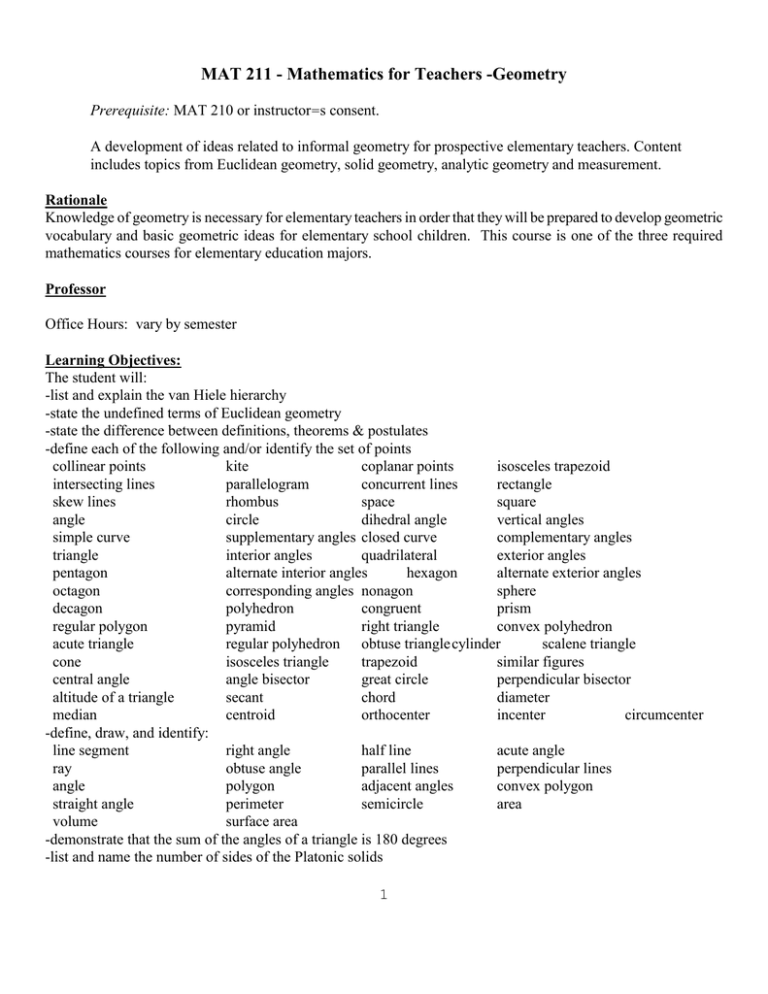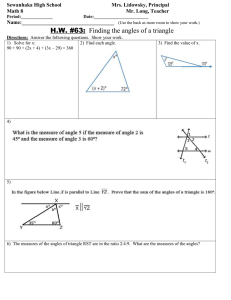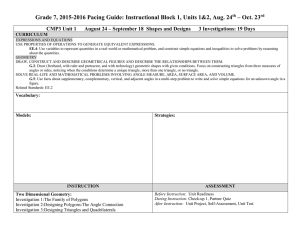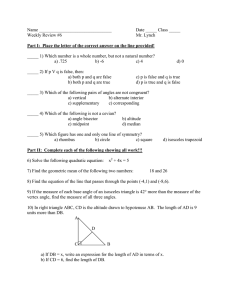MAT 211 - Mathematics for Teachers -Geometry
advertisement

MAT 211 - Mathematics for Teachers -Geometry Prerequisite: MAT 210 or instructor=s consent. A development of ideas related to informal geometry for prospective elementary teachers. Content includes topics from Euclidean geometry, solid geometry, analytic geometry and measurement. Rationale Knowledge of geometry is necessary for elementary teachers in order that they will be prepared to develop geometric vocabulary and basic geometric ideas for elementary school children. This course is one of the three required mathematics courses for elementary education majors. Professor Office Hours: vary by semester Learning Objectives: The student will: -list and explain the van Hiele hierarchy -state the undefined terms of Euclidean geometry -state the difference between definitions, theorems & postulates -define each of the following and/or identify the set of points collinear points kite coplanar points isosceles trapezoid intersecting lines parallelogram concurrent lines rectangle skew lines rhombus space square angle circle dihedral angle vertical angles simple curve supplementary angles closed curve complementary angles triangle interior angles quadrilateral exterior angles pentagon alternate interior angles hexagon alternate exterior angles octagon corresponding angles nonagon sphere decagon polyhedron congruent prism regular polygon pyramid right triangle convex polyhedron acute triangle regular polyhedron obtuse triangle cylinder scalene triangle cone isosceles triangle trapezoid similar figures central angle angle bisector great circle perpendicular bisector altitude of a triangle secant chord diameter median centroid orthocenter incenter circumcenter -define, draw, and identify: line segment right angle half line acute angle ray obtuse angle parallel lines perpendicular lines angle polygon adjacent angles convex polygon straight angle perimeter semicircle area volume surface area -demonstrate that the sum of the angles of a triangle is 180 degrees -list and name the number of sides of the Platonic solids 1 -demonstrate regular and semiregular tilings. -demonstrate: congruence is reflexive, symmetric and transitive triangles are congruent using (SSS, SAS, ASA, AAS) triangles are similar using (SAS, AAA, AA) properties of proportion Triangle inequality -construct with Euclidean tools congruent segments congruent triangles (SSS, SAS) congruent angles parallel lines perpendicular lines (point on line, point not on line) -demonstrate knowledge of the following English units and their relationship to each other: inch foot yard mile square foot square inch square yard cubic inch cubic foot cubic yard pound ton pint quart gallon fluid ounces ounces -demonstrate knowledge of the following Metric prefixes and their relationships to each other: millicentidecideka hectokilo-list and convert within the English and Metric systems using the main units of length, weight, liquid and temperature -compute the perimeter of any polygon or circumference of a circle. -compute the area of: rectangle square triangle parallelogram trapezoid circle sector of a circle -compute the volume and surface area of: prism pyramid cylinder cone sphere -demonstrate the use of the Pythagorean Theorem -demonstrate the rigid motions of: translation reflection rotation -identify the kinds of symmetry to include: reflection symmetry lines of symmetry rotation symmetry rotational symmetry point symmetry Academic Integrity Honesty and integrity are basic virtues expected of all students at Mississippi College. The Mississippi College Undergraduate Catalog lists the policies and penalties for plagiarism and cheating. On tests, quizzes, and individual out-of-class projects, the work is assumed to be the student=s own and no cheating will be tolerated. Topics Basic ideas of geometry - undefined terms, definitions, postulates & theorems Polygonal curves Linear Measurement - metric and English Angles Three dimensional shapes Networks Congruence Constructions Similar triangles Area of polygons and circles Pythagorean Theorem Surface Areas Volumes Mass and temperature Motion Geometry & symmetry Tessellations 2 Methods of Instruction The methods of instruction will include lecture, demonstration using manipulatives and software, calculator use, small group work with manipulatives, group problem solving, small group problem solving, explorations with software, measurement activities, constructions, outside projects, and reviews of journal articles. Students are expected to have a copy of the text, writing materials, access to Geometer’s Sketchpad, a calculator, a compass, a ruler and a protractor. Required Practices Students will participate in individual and small group activities during class time for a quiz grade. Additional activities required are reading the textbook, writing in a geometry journal, Geometer=s Sketchpad explorations, homework assignments, project completion, journal reviews, Internet use to find math information, geometric constructions, quizzes, and tests. Instructional Materials Materials Required: Pencil, text, compass, straightedge, Geometer’s Sketchpad and a calculator. Text: Billstein, R., Liebskind, S. and Lott, J. W. (2010.) A Problem Solving Approach to Mathematics (9th ed.). Addison Wesley. ISBN: 0-321-57055-3 Assessment Assessment of the student=s progress will include group work, homework, projects, evaluation of the geometry journal, and software exploration worth 5-20 points each. Also included are three (probably) regularly scheduled tests worth 100 points each. The final exam is comprehensive and is 150 points. Final grade determination is based on total points accumulated and the following scale: 90-100% of total points - A 80-89% of total points - B 70-79% of total points - C 60-69% of total points - D below 60% of total points - F Other Policies Make-up work: Makeup work is the responsibility of the student and should be cleared with Dr. Floyd in advance if possible. Students are responsible for all material covered and all assignments given when they are absent. Make-up work will only be allowed for excused absences. Make-up work must be scheduled within one week of the absence. Attendance: You are expected to be in class on time and prepared! If you come in after the attendance has been taken, you will be counted absent unless you present an acceptable excuse to Dr. Floyd after class. If you miss a quiz or fail to turn in homework on time because you are tardy, you will receive a 0 for the work. The college stipulates that the grade for the course is automatically an F in the event of 25% or more absences (12 absences). Special Accommodation: If you need special accommodations due to learning, physical, psychological, or other disabilities, please contact Dr. Amy Christian in the Counseling Center in Alumni Hall Room 4. She may be reached by phone at 601-925-7790. Final day to add the class is January 19 at 5:00 p.m. Final day to drop the class is March 26. (No refunds after first week of class.) 3 Dr. Floyd=s Responsibilities: Start/stop on time. Be prepared to explain content and answer questions. Evaluate student performance. Student Responsibilities: Attend ALL classes ON TIME. READ THE TEXTBOOK EACH WEEK. Complete homework every time it is assigned (See Dr. Floyd before the next class if you cannot complete MOST of the homework.) Prepare for examinations. MISSISSIPPI COLLEGE ACADEMIC POLICIES: Students should consult the Mississippi College policy manual located at http://www.mc.edu/resources/publications/policies/ for official information regarding: Class attendance - Policy 2.10 Grading - Policy 2.15 Cheating - Policy 2.19 Counseling and Career Services - Policy 2.25 Research - Policy 2.27 Counseling and Testing Center - Policy 2.34 Students who may require accomodation due to a documented handicap should follow the procedures located at http://www.mc.edu/about/offices/counseling/disabilities/ The Generic Grading Scale for this course is A = 90-100, B = 80-89, C = 70-79, D = 60-69. Individual instructors are free to choose a different grading scheme so students should consult their section's particular syllabus for the official grading scale to be utilized. Tutoring Hours: Hours and location for the departmental tutoring center are posted at http://www.mc.edu/academics/academic-tutoring/ . Student Grade Sheet Test #1 __________ (100) Test #2 __________ (100) Test #3__________ (100) Geometry Journal _______ (20) Project #1 _________(20) Project #2 _________(20) Project #3 _________(20) Project #4 _________(20) Final Exam ______ (150) Daily Grades – Date 4 __________ on __________ __________ on __________ __________ on __________ __________ on __________ __________ on __________ __________ on __________ __________ on __________ __________ on __________ __________ on __________ 5



